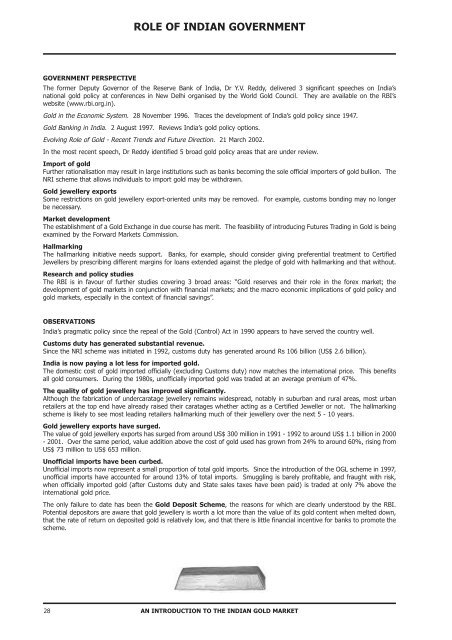Indian Gold Book:Indian Gold Book - Gold Bars Worldwide
Indian Gold Book:Indian Gold Book - Gold Bars Worldwide
Indian Gold Book:Indian Gold Book - Gold Bars Worldwide
You also want an ePaper? Increase the reach of your titles
YUMPU automatically turns print PDFs into web optimized ePapers that Google loves.
ROLE OF INDIAN GOVERNMENT<br />
GOVERNMENT PERSPECTIVE<br />
The former Deputy Governor of the Reserve Bank of India, Dr Y.V. Reddy, delivered 3 significant speeches on India’s<br />
national gold policy at conferences in New Delhi organised by the World <strong>Gold</strong> Council. They are available on the RBI’s<br />
website (www.rbi.org.in).<br />
<strong>Gold</strong> in the Economic System. 28 November 1996. Traces the development of India’s gold policy since 1947.<br />
<strong>Gold</strong> Banking in India. 2 August 1997. Reviews India’s gold policy options.<br />
Evolving Role of <strong>Gold</strong> - Recent Trends and Future Direction. 21 March 2002.<br />
In the most recent speech, Dr Reddy identified 5 broad gold policy areas that are under review.<br />
Import of gold<br />
Further rationalisation may result in large institutions such as banks becoming the sole official importers of gold bullion. The<br />
NRI scheme that allows individuals to import gold may be withdrawn.<br />
<strong>Gold</strong> jewellery exports<br />
Some restrictions on gold jewellery export-oriented units may be removed. For example, customs bonding may no longer<br />
be necessary.<br />
Market development<br />
The establishment of a <strong>Gold</strong> Exchange in due course has merit. The feasibility of introducing Futures Trading in <strong>Gold</strong> is being<br />
examined by the Forward Markets Commission.<br />
Hallmarking<br />
The hallmarking initiative needs support. Banks, for example, should consider giving preferential treatment to Certified<br />
Jewellers by prescribing different margins for loans extended against the pledge of gold with hallmarking and that without.<br />
Research and policy studies<br />
The RBI is in favour of further studies covering 3 broad areas: “<strong>Gold</strong> reserves and their role in the forex market; the<br />
development of gold markets in conjunction with financial markets; and the macro economic implications of gold policy and<br />
gold markets, especially in the context of financial savings”.<br />
OBSERVATIONS<br />
India’s pragmatic policy since the repeal of the <strong>Gold</strong> (Control) Act in 1990 appears to have served the country well.<br />
Customs duty has generated substantial revenue.<br />
Since the NRI scheme was initiated in 1992, customs duty has generated around Rs 106 billion (US$ 2.6 billion).<br />
India is now paying a lot less for imported gold.<br />
The domestic cost of gold imported officially (excluding Customs duty) now matches the international price. This benefits<br />
all gold consumers. During the 1980s, unofficially imported gold was traded at an average premium of 47%.<br />
The quality of gold jewellery has improved significantly.<br />
Although the fabrication of undercaratage jewellery remains widespread, notably in suburban and rural areas, most urban<br />
retailers at the top end have already raised their caratages whether acting as a Certified Jeweller or not. The hallmarking<br />
scheme is likely to see most leading retailers hallmarking much of their jewellery over the next 5 - 10 years.<br />
<strong>Gold</strong> jewellery exports have surged.<br />
The value of gold jewellery exports has surged from around US$ 300 million in 1991 - 1992 to around US$ 1.1 billion in 2000<br />
- 2001. Over the same period, value addition above the cost of gold used has grown from 24% to around 60%, rising from<br />
US$ 73 million to US$ 653 million.<br />
Unofficial imports have been curbed.<br />
Unofficial imports now represent a small proportion of total gold imports. Since the introduction of the OGL scheme in 1997,<br />
unofficial imports have accounted for around 13% of total imports. Smuggling is barely profitable, and fraught with risk,<br />
when officially imported gold (after Customs duty and State sales taxes have been paid) is traded at only 7% above the<br />
international gold price.<br />
The only failure to date has been the <strong>Gold</strong> Deposit Scheme, the reasons for which are clearly understood by the RBI.<br />
Potential depositors are aware that gold jewellery is worth a lot more than the value of its gold content when melted down,<br />
that the rate of return on deposited gold is relatively low, and that there is little financial incentive for banks to promote the<br />
scheme.<br />
28<br />
AN INTRODUCTION TO THE INDIAN GOLD MARKET

















